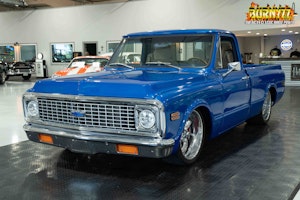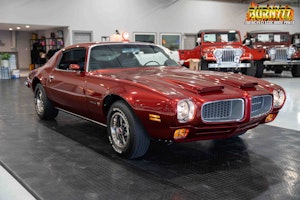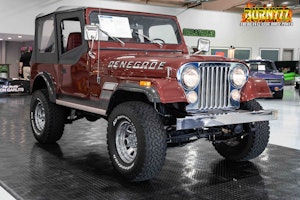Media | Articles
Ford’s 1965–68 Galaxie Was Quieter Than a Rolls. Its Values Are Anything but Subdued
By 1965, Ford was pushing its Total Performance concept in every vehicle from the fuel-sipping Falcon to the range-topping Thunderbird. While the tie-in to Ford’s motorsports efforts was obvious, Total Performance also included the notion of durability, practicality, value, and luxury. Perhaps there was no better example of the breed than the full-size Ford Galaxie for 1965, and its premium LTD trim level for those seeking performance in its totality (as it were). The sales brochure suggested these Galaxies were “the most changed cars you’ve seen in a decade.”
That’s not marketing hyperbole, as a new 3-link rear suspension utilized a Panhard bar and replaced the clumsy leaf springs of the era with a modern coil setup. The Galaxie’s new 15-inch wheels with lower profile tires were harder to find outside of luxury cars of the era. But what made the 1965-68 Ford Galaxie so special was a body-on-frame design that eschewed the notion that stiffer is always better. Opting for a strategic flexibility program that implemented torque boxes and rubber body mounts all the way back in 1965 was certainly something to talk about. It was another example of Total Performance, especially when it came to reducing NVH levels.
And all the hard work from Ford’s designers and engineers deserved an advertising campaign that proved the point. Working with trusted advertising parter J. Walter Thompson, the hardtop 1965 Galaxie 500 LTD became famous for being quieter than a Rolls-Royce, mostly because of the revised suspension and radical frame. The design was unique in the Ford lineup, as even the Lincoln Continental still used leaf springs at the rear, with a unitized chassis lacking the LTD’s balance of stiffness, flexibility, and NVH reduction technology.



The new 1965 Galaxie sold as well as it rode, besting the prior year’s sales by over 55,000 units (978,429 in total). There were six body styles (pillared sedan/coupe, hardtop sedan/coupe, convertible, station wagon), and trim levels offering luxury (LTD), higher performance (XL), or posh practicality (Country Squire Wagon). A wide range of engines, from a new 240-cid inline six (a descendent of Ford’s legendary 300 inline six truck motor) to the rare 427-cid V-8 (available with a four-barrel carb or dual quads), made the Galaxie a full-size vehicle for every taste and budget. But 1965 was only the start of something special, as sales skyrocketed to over one million Galaxies (1,034,930) the following year.



The 1966 Galaxie was restyled with softer contours that belied the hard-nosed performance with the newly available 428-cid Thunderbird V-8 with 345 horsepower. Dubbed the “7-Litre” Galaxie, it slotted between the relatively tamer 390 (315 horsepower) and the radical 427 (425 horsepower) V-8 engines. The 7-Litre trim could be had with the fire-breathing 427, but these days enthusiasts typically reference the 428 as the 7-Litre or call out the 427 directly.
Marketplace
Buy and sell classics with confidence
Values for the second-generation Galaxie do vary somewhat year to year, but the selection of ’66 Galaxie trims below do afford a representative sample. Regardless of trim, 427-equipped cars occupy the top spots, with less-powerful engines rendering the cars they’re in considerably more affordable. While available in every body style, the 428-powered 7-Litre hardtop coupes in #2 condition are now valued at $60,000, much closer to the 390 ($34,300) compared to the 427 ($141,000). Across the board, though, even in a flatter market, values are stable for entry-level Galaxies and on the upswing for the more powerful examples. Four-speed cars command a 10 percent premium, and, if you’re seeking the looks of a Galaxie at a significant discount, six-cylinder cars tend to be worth about 20 percent less than the lowest value V-8.

The Galaxie is a popular 1960s choice across all ages. Insurance quotes sought from Gen X owners are up three percentage points over the last five years, and five percentage points in the same period among both millennials and Gen Z. Between the interest among younger enthusiasts and the sheer number of Galaxies made, we can expect to see them being enjoyed for years to come.


The 1967 Galaxie received even softer styling than the 1966 model, and all the same engines were available (but lacking the 7-Litre moniker). A revised dashboard sported an integrated “Stereo Sonic” tape player where the 1966 had it mounted below the dashboard. Mandated safety features also applied to the Galaxie, from a padded horn button with an energy-absorbing steering column, to a dual bore master cylinder. For 1968, the final year of this body style, Ford gave the Galaxie new front and rear fascias, side marker lights, and horizontally arranged headlights. Concealed headlights were available on the LTD and sporty XL, and the base V-8 transitioned from the 289-cid to the 302-cid small block V-8.
And that’s where it should end, but Ford took this winning template to the next level. An entirely new platform for 1969 had a track “as wide as a Cadillac”, more front head and leg room than Chrysler’s Imperial, and a design that’s “even quieter than the LTD that was quieter than a Rolls-Royce.” Rarely does a trim level create a legacy with such gravity, and by 1974 the LTD actually killed the Galaxie brand beneath it.
And the LTD name was still associated with a Rolls-Royce throughout the Malaise Era, a time when a vehicle’s luxurious attributes took precedent over performance. (Though the downsized LTD was “as quiet as a Rolls-Royce” and no longer superior to the iconic English saloon.) So perhaps the 1965 Ford Galaxie was ahead of its time, and three decades of subsequent Ford flagship sedan history owe it a debt of gratitude.
***
Check out the Hagerty Media homepage so you don’t miss a single story, or better yet, bookmark it. To get our best stories delivered right to your inbox, subscribe to our newsletters.




















My first car was a ‘65 Custom 4 door with a 289 and Cruis-O-Magic with a glass pack on it. I never drove it on the street, I was 14. Bought it for $100 because the frame was rusted out under the drivers door, but it was relatively rust free I loved the sound of the glass pack.
I would love to have the Ford Galaxy 500 we had when I was growing up. Red and white 4 door sedan.
I was 6 years old when my aunt & uncle got their 1967 galaxie 500 4 door with a 390
We went on a road trip to randsburg that they had gotten from the ford dealer, they was a tv show that showed local trips in so cal that ford sponsored.
I got the car after they had it for 20 years always garaged it was cherry
I drove it every day for a about 4 years put a 100,000 miles on it took it apart then my dad bought a 66 bronco we did a ground up resto in so he co I l d use it to go rock crawling all over the southwest and then my family life got in front of me.
Just got it back from body shop ,painted it the stock tan whith a white hard top
Putting it back together now so I can take my grand kids on some road trips.